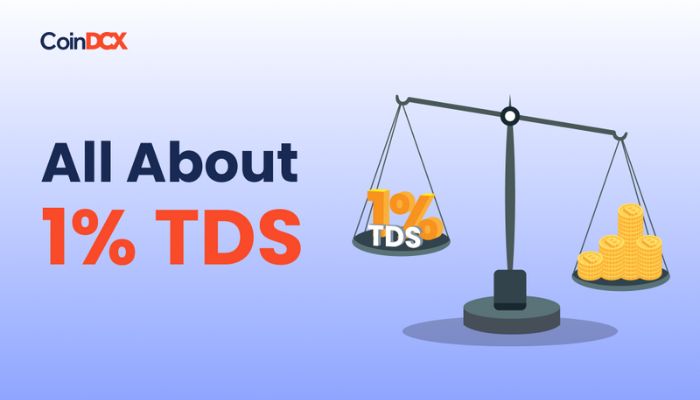As the Indian government becomes more open to digital assets, a tax deducted at source (TDS) on crypto trades was applied. When this new rule goes into effect in July 2022, it will make it easier to collect taxes and give more information about the cryptocurrency market. Nevertheless, Indian buyers may find it challenging to understand how to calculate TDS on crypto. Knowing how to handle your crypto taxes with confidence is made easier by this piece. Let’s know more about “How to Calculate TDS on Cryptocurrency Transactions in 2024- Tips for Indian Investor.
Understanding TDS on Crypto Transactions in India
The addition of a 1% TDS to crypto payments over ₹10,000 in a financial year (FY) is a big change in the state of crypto in India. According to cleartax.in This TDS payment helps lower your total crypto tax bill. Here is a list of vital information to keep in mind:
- TDS Rate: The amount paid (in INR) to move crypto assets is reduced by a flat 1%.
- Applicable Transactions: Buyers and sellers of cryptocurrencies in India must pay transaction fees (TDS) when using P2P sites or Indian exchanges.
- Threshold Limit: Transactions below ₹10,000 in a financial year usually don’t have to pay TDS. Although, some sites may take TDS out no matter how much is paid. Please read the platform’s rules carefully.
Calculating Your TDS on Crypto Transactions: A Step-by-Step Guide:
Calculating TDS on your cryptocurrency purchases is a simple process. Following steps will help you do it:
1. Identify the Transaction Value: Finding the amount of money you paid in Indian Rupees to buy or sell the coin. While getting crypto, this could be the purchase price. When selling crypto, this could be the sale proceeds.
2. Apply the TDS Rate: Divide the amount of the transaction by the 1% TDS rate.
Example: If you bought Bitcoin for ₹50,000 on a cryptocurrency exchange:
INR50,000 was paid for the transaction.
The TDS rate is 1%.
Total TDS (INR) = Amount of the Transaction x TDS Rate, which in this case is 1% of ₹50,000, or ₹500.
3. Account for Platform Deductions: As part of the transaction, many Indian cryptocurrency exchanges take TDS out immediately.
4. Track Your TDS Records: Record all of your crypto transactions correctly, including the date, the amount, any TDS that was taken out (if any), and any supporting papers like exchange receipts or P2P transaction confirmations.
TDS and Your Crypto Tax Filing: What You Need to Know:
You get the TDS taken out of your cryptocurrency trades credited to your Permanent Account Number (PAN) by the platform that handles the transaction. When you file your crypto taxes, TDS alters the following:
- TDS on ITR Filing: When you file your Income Tax Return (ITR), Form 16A (for TDS deducted by designated people) will show the TDS that was taken out of your crypto transactions.
- Adjusted Tax Liability: As a result of the TDS amount being taken out, your crypto tax bill is already paid. During the ITR filing process, you can claim credit for the TDS that you subtracted, which could lower the total amount of tax you have to pay.
Important Note: This piece gives a basic outline of TDS on cryptocurrency transactions in India. Discuss your tax situation with a licenced tax professional who is familiar with the rules surrounding cryptocurrencies. This will gives you related information to “How to Calculate TDS on Cryptocurrency Transactions in 2024- Tips for Indian Investor”.
Read More:-Steps to Resolve a Bank Account Freeze Caused by Crypto P2P Transactions
Tips for Indian Crypto Investors: Keeping Your TDS Records Organized
Assisting you in easily handling the TDS on cryptocurrency transactions:
- Utilize Exchange Statements: In most cases, crypto exchanges give thorough transaction statements that show how much TDS was taken out of each transaction. You can save these notes to your computer for future reference.
- Maintain P2P Transaction Records: Keep copies of invoices, receipts, and messages you send and receive with your counterparty for peer-to-peer transfers as proof of the value of the transaction and a possible TDS application.
- Consider Crypto Tax Software: Consider crypto tax software that can help you keep track of your transactions, figure out TDS. And make tax reports that will make filing your ITR easy.
For Indian crypto investors, knowing the basics of TDS on crypto deals and keeping good records can help them feel more confident about their crypto tax obligations. Bear in mind that staying educated and talking to a tax expert if necessary can make sure that filing your crypto taxes goes smoothly and legally. I hope you like all information “How to Calculate TDS on Cryptocurrency Transactions in 2024- Tips for Indian Investor”.
Disclaimer: There is no tax help in this article; it is only meant to teach you something. Talk to a licenced tax professional about your case.







